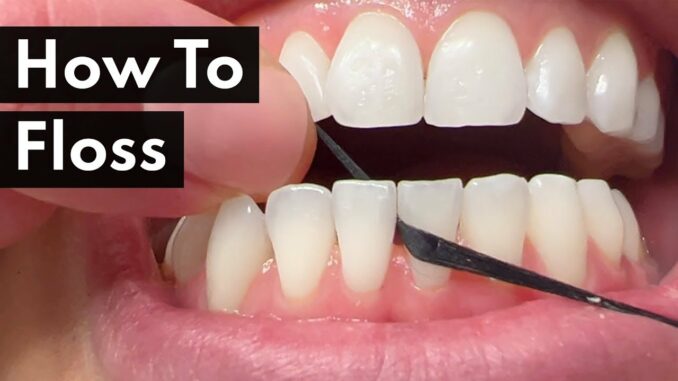
The Definitive Guide to Flossing Correctly: Techniques, Tips, and Benefits for Optimal Oral Health
Flossing is an essential component of any effective oral hygiene routine, yet it is often overlooked or performed incorrectly by many individuals. Proper flossing helps to remove plaque and food particles from between the teeth and along the gumline, reducing the risk of cavities, gum disease, and other oral health problems. In this comprehensive guide, we’ll delve into everything you need to know about flossing correctly, including techniques, tips, and the benefits of incorporating this important practice into your daily routine.
Understanding the Importance of Flossing:
Before we explore how to floss correctly, let’s first understand why it’s such a crucial aspect of oral hygiene:
- Plaque Removal: Flossing helps to remove plaque, a sticky film of bacteria that forms on the surfaces of your teeth and along the gumline. If left unchecked, plaque can lead to tooth decay, gum disease, and other oral health issues.
- Prevention of Cavities: Flossing removes food particles and plaque from between the teeth, reducing the risk of cavities and decay in those hard-to-reach areas.
- Gum Health: Flossing helps to clean between the teeth and along the gumline, preventing the buildup of plaque and bacteria that can lead to gum disease and inflammation.
- Fresh Breath: By removing food particles and bacteria from between the teeth, flossing helps to prevent bad breath and keep your mouth feeling clean and fresh.
Choosing the Right Type of Floss:
Before you can begin flossing correctly, it’s essential to choose the right type of floss for your needs. Here are some options to consider:
- Waxed vs. Unwaxed: Waxed floss is coated with a thin layer of wax, making it easier to slide between tight spaces and less likely to shred or fray. Unwaxed floss may be better suited for individuals with wider gaps between their teeth.
- Flavored vs. Unflavored: Flavored flosses, such as mint or cinnamon, can leave your mouth feeling fresh and clean after flossing. Unflavored floss is a suitable option for those who prefer a more neutral taste.
- Floss Picks vs. Traditional Floss: Floss picks are disposable, plastic devices with a small length of floss attached to one end, making them convenient for on-the-go flossing. Traditional floss comes in a spool and requires wrapping around your fingers for use.
Proper Flossing Techniques:
Now, let’s explore the step-by-step process of flossing correctly:
- Measure the Floss: Start by breaking off a piece of floss that is approximately 18-24 inches long. Wrap the ends of the floss around your middle fingers, leaving a few inches of floss to work with.
- Hold the Floss: Hold the floss tightly between your thumbs and forefingers, leaving about one inch of floss between them. This will allow you to maneuver the floss between your teeth and along the gumline effectively.
- Gently Guide the Floss: Using a gentle sawing motion, guide the floss between your teeth, being careful not to snap or force it. If you encounter resistance, try gently wiggling the floss back and forth until it slides between your teeth.
- Curve the Floss: Once the floss is between your teeth, curve it into a C-shape around the side of one tooth. Slide the floss up and down along the side of the tooth, making sure to reach below the gumline.
- Switch Sides: After cleaning one side of the tooth, move the floss to the other side and repeat the process. Be sure to use a clean section of floss for each tooth to prevent transferring bacteria.
- Repeat for Each Tooth: Continue flossing each tooth, moving from one tooth to the next until you have cleaned between all of your teeth, including the back molars.
- Rinse and Dispose: After flossing, rinse your mouth thoroughly with water to remove any loosened plaque or debris. Dispose of the used floss in the trash.
Additional Tips for Effective Flossing:
- Be Gentle: Avoid snapping or forcing the floss between your teeth, as this can cause injury to your gums or damage to your tooth enamel.
- Take Your Time: Flossing requires patience and precision. Take your time to ensure that you are cleaning between each tooth thoroughly.
- Floss Daily: Aim to floss at least once a day, preferably before bedtime, to remove plaque and food particles that have accumulated throughout the day.
- Use Floss Picks if Necessary: If traditional flossing is challenging for you, consider using floss picks or other interdental cleaning devices to make the process easier and more comfortable.
- Combine with Brushing: Flossing should be complemented by regular brushing and other oral hygiene practices, such as using mouthwash and visiting your dentist for professional cleanings and check-ups.
Conclusion:
Flossing correctly is an essential aspect of maintaining good oral hygiene and preventing oral health problems such as cavities, gum disease, and bad breath. By choosing the right type of floss, mastering proper flossing techniques, and incorporating flossing into your daily routine, you can achieve optimal oral health and a bright, healthy smile. Remember to be gentle, take your time, and floss consistently to reap the full benefits of this important oral care practice. With these tips and techniques in mind, you’ll be well on your way to a lifetime of healthy teeth and gums.